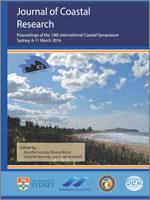Araujo, M.; Medeiros, C. and Endres, J-P., 2016. An Analytic Approach to Model the Tidal Circulation in a Double-inlet Estuary. In: Vila-Concejo, A.; Bruce, E.; Kennedy, D.M., and McCarroll, R.J. (eds.), Proceedings of the 14th International Coastal Symposium (Sydney, Australia). Journal of Coastal Research, Special Issue, No. 75, pp. 223-227. Coconut Creek (Florida), ISSN 0749-0208.
Estuaries comprise broad spectra of systems whose morphology often rule theirs hydrodynamics. The Itamaracá estuarine system (NE-Brazil) is formed by the Santa Cruz Channel (SCC), connecting to the Atlantic Ocean through two inlets. Water level and in depth current measurements were used to evaluate an analytical approach for representing its tidal circulation. Depth-averaged currents were analytically predicted with 11% error (δ1 = 0.11). Currents measurements for five different sampling stations and depths were compared to model responses for various values of eddy viscosity (ν) and bottom friction parameter (r). The best-fit quadratic error δ2 = 0.155 was obtained with ν = 6.3×10−3m2s−1 and r = 6.5×10−3ms−1. Model improvements, considering bottom friction and eddy diffusivity formulations, indicated a boundary layer depth of 0.10H (H=channel depth), and a large (6.1×10−3m) mean roughness length of the sea-bed to couple with the intricate roots system of red mangroves along the SCC. Simulations were also used to test Taylor's (1954) scale analysis, yielding c = 0.080 as best value (c = ν/u*H constant; u* =bottom friction velocity) and a mean eddy viscosity of 5.8×10−3 m2s−1). The low sensibility of momentum distribution to changes in eddy viscosity verified suggests that stronger viscosity dumping may be compensated by higher bottom shear stress. This simple analytical approach could also be used to predict spatial and temporal distribution of pollutants and other materials at SSC and at similar systems as advection of those components could easily be simulated combining modelled currents with measurements of theirs concentrations.





